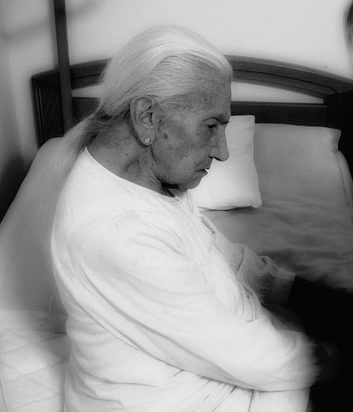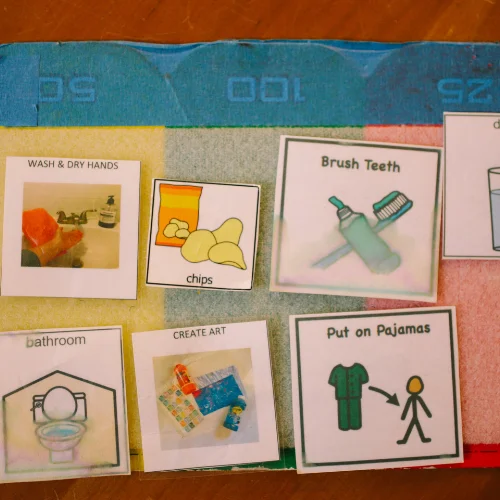Making Eye Contact with Someone with Dementia
Have you ever heard the saying, “Eyes are the windows to the soul”? Well, when it comes to connecting with someone with dementia, making eye contact can be a powerful tool. Dementia is a condition that affects millions of people worldwide, including many in the US. It can cause memory loss, confusion, and communication difficulties. Further, I will talk about the importance of eye contact when interacting with individuals with dementia, and how it can enhance their well-being and sense of connection.
Understanding Dementia

Before we delve into the significance of eye contact, let’s take a moment to understand what dementia is. Dementia is a syndrome characterized by a decline in cognitive abilities, including memory, thinking, and behavior. It affects different individuals in various ways, making each person’s experience unique. Alzheimer’s disease, vascular dementia, and Lewy body dementia are some common types of dementia. It’s important to note that dementia does not define a person, but it does impact their ability to communicate effectively.
The Power of Eye Contact

Eye contact is a fundamental aspect of human interaction. It allows us to convey emotions, build connections, and establish trust. When communicating with someone with dementia, eye contact takes on even greater significance. Making eye contact can help bridge the gap created by communication difficulties, enabling a deeper connection and understanding. It can provide reassurance, validation, and a sense of being seen and heard.
Enhancing Communication

One of the challenges individuals with dementia face is expressing their thoughts and emotions. Language and memory impairments can make it difficult for them to articulate their needs and desires. Making eye contact can help overcome these barriers and improve communication. By maintaining eye contact, you signal your attentiveness and show that you are fully present in the conversation. This visual cue can prompt the person with dementia to feel more comfortable and engaged, increasing their willingness to communicate.
Establishing Trust and Comfort

Imagine being in a room full of unfamiliar faces. You might feel anxious, unsure, or even scared. Now, think about how someone with dementia might experience that same situation. Dementia can create feelings of confusion and disorientation, particularly in unfamiliar environments. Making eye contact can help establish a sense of trust and comfort. When you lock eyes with someone with dementia, it signals that you are a safe and approachable presence. It can make them feel more at ease and willing to engage in conversation or activities.
Non-Verbal Communication

Communication is not solely reliant on words. Non-verbal cues often play a significant role in conveying messages and emotions. For individuals with dementia who struggle with language, non-verbal communication becomes even more important. Eye contact serves as a powerful non-verbal cue, enabling the person with dementia to understand your intentions, emotions, and empathy. It helps them interpret your body language and facial expressions, allowing for a deeper connection and mutual understanding.
Being Mindful of Cultural Differences

In a multicultural society like the US, it’s essential to be mindful of cultural differences when it comes to eye contact. Different cultures have varying norms and expectations regarding eye contact. In some cultures, prolonged eye contact may be considered disrespectful or confrontational, while in others, it may be a sign of attentiveness and respect. When interacting with someone with dementia from a different cultural background, it’s crucial to adapt your approach to respect their cultural norms while still prioritizing their comfort and well-being.
How can I overcome my discomfort and hesitation when making eye contact with someone with dementia?
First and foremost, it is important to approach the person with empathy and understanding. Recognizing that individuals with dementia may have difficulty maintaining eye contact due to their cognitive condition can help you adjust your expectations and response.
Instead of solely relying on eye contact, focus on other non-verbal cues such as facial expressions and body language, which can provide valuable insight into their emotions and needs.
For instance, if you notice a smile or a furrowed brow, it can indicate their level of comfort or discomfort, allowing you to respond accordingly.
Another helpful strategy is to establish a connection through gentle and respectful engagement. Begin by introducing yourself and addressing the person by their name, if known, to establish a sense of familiarity.
Maintain a calm and soothing tone while speaking, as this can promote a relaxed environment. By speaking slowly and clearly, and using simple and concise sentences, you can enhance understanding and minimize confusion.
Engaging in activities together, such as flipping through photo albums or engaging in light physical exercises, can also provide opportunities for connection without solely relying on eye contact.
It can be beneficial to educate yourself about dementia and its symptoms to gain a deeper understanding of the condition. This knowledge can help you approach interactions with empathy and patience. Remember that individuals with dementia may have good days and bad days, and their ability to maintain eye contact can fluctuate. Being aware of this variability can help you manage your expectations and prevent feelings of frustration.
In addition, seeking support from professionals and support groups can be invaluable. These resources can provide guidance, advice, and emotional support, allowing you to navigate the challenges of interacting with someone with dementia more effectively.
Sharing experiences with others who have faced similar situations can help alleviate feelings of discomfort and provide helpful strategies for communication.
What are some strategies to encourage eye contact without overwhelming or confusing the person with dementia?
When interacting with individuals with dementia, encouraging eye contact can enhance communication and connection. However, it is crucial to approach this gently and considerately to avoid overwhelming or confusing the person. One effective strategy is to position yourself at eye level. By aligning your gaze with theirs, you create a more comfortable and natural environment for eye contact.
For instance, if you are sitting in a chair while they are in a wheelchair, adjusting your position to be at their eye level promotes engagement. This strategy allows you to establish a connection without imposing any pressure or discomfort on the person with dementia.
Another helpful approach is to maintain a relaxed and friendly demeanor. Smiling and speaking softly can make the person feel at ease and more willing to engage visually. Offering reassuring gestures, such as a gentle touch on the arm or holding their hand, can provide a sense of security and encourage eye contact.
It is important to be patient and give the person with dementia time to process and respond. Rushing or becoming frustrated may lead to confusion or distress. For example, you can calmly wait for a few seconds after asking a question before expecting a response, allowing them to gather their thoughts and establish eye contact.
Using visual cues or prompts can also be effective. Holding up an object or pointing to something of interest can draw the person’s attention and encourage them to make eye contact. For instance, if you’re discussing a family photo album, you can gently guide their focus to a specific picture by pointing at it. This gentle redirection can help them maintain eye contact while remaining focused and engaged in the conversation.
Lastly, creating a comfortable and familiar environment can promote eye contact. Minimizing distractions and ensuring adequate lighting can help the person focus on the conversation and establish eye contact more easily.
Choosing a quiet and calm setting, free from excessive noise or visual clutter, can also aid their concentration and encourage visual connection. For example, you can have conversations in a peaceful corner of a room or a familiar space where the person feels at ease.
Are there any cultural considerations I should keep in mind when attempting to establish eye contact with someone from a different background who has dementia?

When establishing eye contact with someone from a different background who has dementia, it’s important to be aware of cultural considerations. Cultural norms and expectations surrounding eye contact vary across different communities and can influence how individuals perceive and respond to direct eye contact. In the United States, maintaining eye contact is generally seen as a sign of attentiveness and respect during a conversation.
However, it’s essential to recognize that other cultures may have different interpretations and preferences. For instance, in some Asian cultures, prolonged eye contact can be considered disrespectful or confrontational. Therefore, when interacting with someone from a different background who has dementia, it’s crucial to approach eye contact with sensitivity and adapt to their cultural background.
One key aspect to consider is individual differences within cultures. While it’s helpful to have a general understanding of cultural norms, it’s important to remember that individuals may have unique experiences and preferences.
For example, a person with dementia from a particular cultural background may have been raised in a different environment or may have developed their personal preferences over time. Therefore, it’s essential to approach each person with an open mind and observe their cues and responses during interactions.
Communication style is another critical factor to consider when establishing eye contact. In some cultures, direct eye contact is not the primary mode of communication. Instead, individuals may rely more on nonverbal cues or prefer indirect eye contact.
For instance, in Native American cultures, maintaining eye contact can be seen as intrusive or disrespectful, especially when dealing with elders or authority figures. In such cases, it may be more appropriate to establish a connection through other means, such as active listening, gentle touch, or verbal reassurance.
Furthermore, it’s important to respect personal boundaries and adapt your behavior accordingly. Some individuals with dementia may find direct eye contact uncomfortable or distressing, regardless of cultural considerations.
In such instances, it’s crucial to prioritize the person’s comfort and well-being over any cultural expectations. You can demonstrate your attentiveness and connection in alternative ways, such as maintaining a relaxed posture, speaking in a calm and reassuring tone, or using gentle gestures to convey empathy and understanding.
How can making eye contact enhance communication and connection with individuals with dementia?
Making eye contact can greatly enhance communication and connection with individuals with dementia. Firstly, eye contact serves as a powerful nonverbal cue that signals attentiveness and interest. When we maintain eye contact with someone, it shows that we are fully present and engaged in the conversation. This can be particularly important for individuals with dementia, as they may struggle with memory and cognitive impairments.
By establishing eye contact, we convey a sense of respect and validate their presence, helping them feel acknowledged and valued. For example, imagine a person with dementia sharing a story from their past. By maintaining eye contact and actively listening, we demonstrate our genuine interest in their experiences, creating a meaningful connection.
Secondly, eye contact can aid in comprehension and understanding. People with dementia may face challenges in processing information and following conversations. When we establish eye contact, we provide a visual focus that can help them concentrate and stay engaged. By looking directly at them, we also allow them to observe our facial expressions, which often convey emotions and provide additional context to the conversation.
For instance, if someone with dementia is sharing a concern or expressing sadness, maintaining eye contact allows us to respond empathetically with a comforting smile or a gentle touch, fostering a sense of connection and emotional support.
Furthermore, eye contact facilitates nonverbal communication. Individuals with dementia may experience difficulties with language or struggle to find the right words. By using eye contact, we can establish a channel of nonverbal communication that transcends words. A warm and reassuring gaze can convey understanding, empathy, and reassurance. It can help bridge the communication gap and enable individuals with dementia to express themselves more fully.
For instance, if a person with dementia becomes agitated or anxious, maintaining eye contact while adopting a calm and soothing demeanor can communicate a sense of security, reducing distress and promoting a sense of trust.
Conclusion
Making eye contact with someone with dementia can be a powerful means of communication and connection. It helps bridge the gap caused by cognitive impairments and enhances the overall well-being of individuals with dementia.
By maintaining eye contact, we can establish trust, improve communication, and create a sense of comfort for those living with this condition. So, the next time you interact with someone with dementia, remember the power of your gaze and the profound impact it can have on their lives.
Have you had any experiences making eye contact with someone with dementia? How did it affect the interaction?
Please share your thoughts and stories in the comments section below. Let’s engage in a meaningful conversation!
